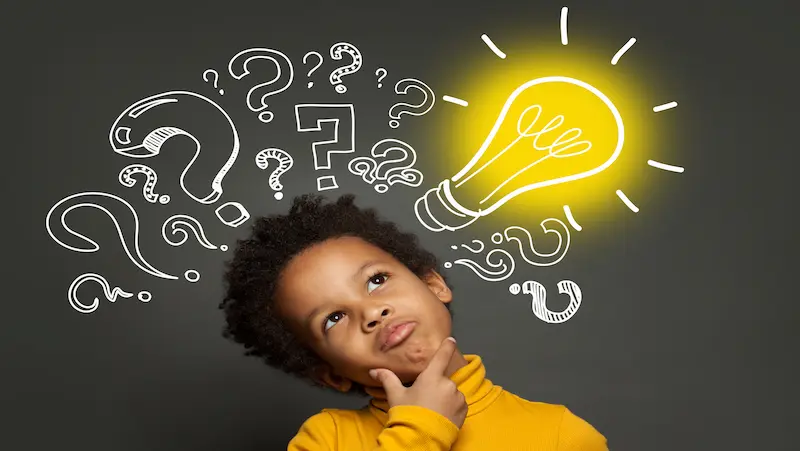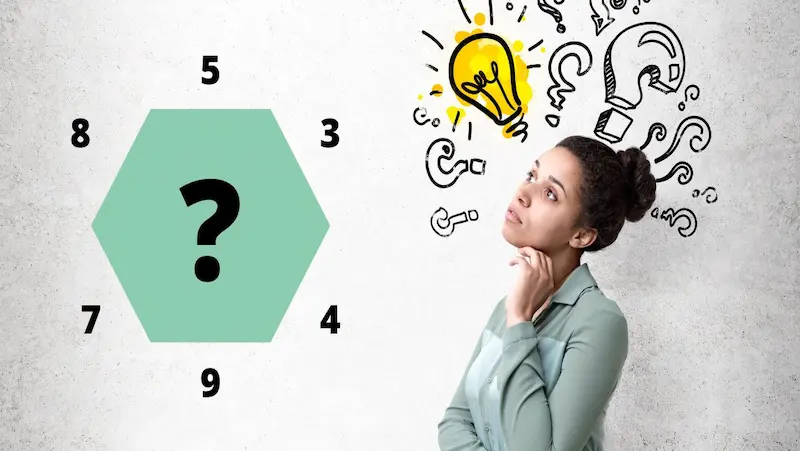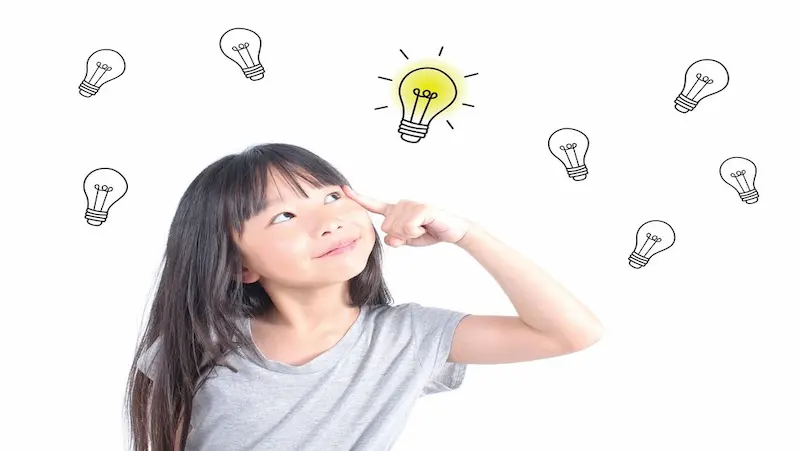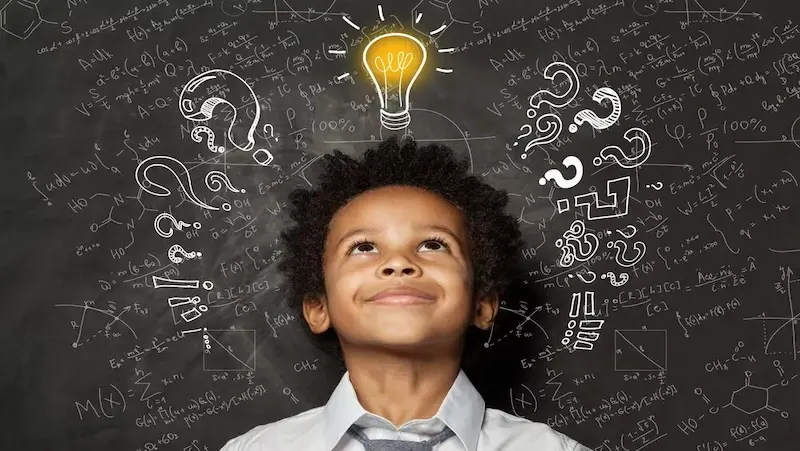I am a treasure that can’t be seen,
I’m gained through learning, far and wide,
Helping minds grow, expand, and stride.
With books and facts, I’m found,
In classrooms, libraries all around.
What am I? 🤔
Yes, you guessed it right. Its knowledge!
Calling all parents and kids! Join us on an exciting adventure of Brain teasers and riddles in this blog.
Engaging brain teasers are an excellent tool to enhance children’s cognitive skills while keeping them entertained. These puzzles challenge young minds and encourage critical thinking, problem-solving, and logical reasoning.
By presenting intriguing scenarios, riddles, or visual puzzles, brain teasers stimulate creativity and improve memory retention. They foster mental agility and promote analytical skills in a fun and interactive manner.
Brain teasers also help develop perseverance and patience as children work through different levels of difficulty. From number patterns to word games, these brain teasers engage kids in active learning, ultimately boosting their cognitive abilities and preparing them for future academic and real-life challenges.
Table of contents
Introduction
Brain teasers play a crucial role in the cognitive development of children, offering numerous benefits along the way. Firstly, they enhance critical thinking skills by presenting complex problems that require analysis, evaluation, and logical reasoning. By engaging with brain teasers, kids learn to think outside the box, explore multiple perspectives, and develop innovative solutions.
Moreover, brain teasers stimulate problem-solving abilities, as they require systematic approaches and the application of strategies to find solutions. These puzzles encourage children to break down problems into smaller parts, fostering their ability to tackle complex challenges effectively.
Brain teasers also promote memory retention and cognitive flexibility. This enhances memory skills and strengthens the brain’s ability to switch between different tasks or strategies.
Overall, brain teasers provide a fun and interactive way to boost cognitive skills, including critical thinking, problem-solving, memory, and adaptability. By engaging in these challenges, children acquire essential skills that will benefit them academically and in various real-life situations.
Benefits of Brain Teasers for Kids
Solving brain teasers offers a multitude of advantages for kids, helping them develop valuable skills and abilities. Here are some key advantages:
1. Enhanced Problem-Solving Skills: Brain teasers present children with problems that require creative thinking and innovative approaches. By engaging with these puzzles, kids learn to break down complex problems into smaller, more manageable parts, develop effective problem-solving strategies, and think critically to find solutions.
2. Improved Critical Thinking Abilities: Brain teasers challenge children to analyze information, evaluate options, and make informed decisions. They encourage logical reasoning, pattern recognition, and the ability to draw connections between different pieces of information. This enhances children’s critical thinking abilities, enabling them to approach challenges from different angles and consider multiple perspectives. Developing critical thinking skills for kids is essential as it empowers them to analyze, reason, and make informed decisions, setting a strong foundation for lifelong learning and problem-solving abilities
3. Strengthened Concentration and Focus: Solving brain teasers requires concentration and attention to detail. Kids need to stay focused on the problem at hand, pay attention to clues and hints, and avoid distractions. Regular engagement with brain teasers can improve a child’s ability to concentrate for longer periods, ultimately enhancing their overall focus and attention span.
4. Boosted Creativity and Out-of-the-Box Thinking: Brain teasers often have unconventional solutions that require kids to think outside the box. By engaging in these puzzles, children’s creativity is stimulated as they explore new ideas, alternative perspectives, and unconventional approaches to problem-solving. Also, Engaging in art projects for kids not only unleashes their creativity but also nurtures their self-expression and confidence in exploring the colorful world of imagination
5. Increased Memory Retention: Many brain teasers involve remembering and recalling information, such as numbers, patterns, or sequences. Regular practice with brain teasers can improve children’s memory skills, both short-term and long-term, as they train their brains to retain and retrieve information more effectively.
6. Enhanced Cognitive Skills Transfer: The cognitive skills developed through solving brain teasers can transfer to various areas of a child’s life. These skills can benefit academic performance, as kids learn to apply critical thinking and problem-solving strategies in subjects like math, science, and language arts. Moreover, the skills gained from brain teasers can be applied to real-life situations, such as analyzing problems, making decisions, and adapting to new challenges.
Overall, solving brain teasers offers numerous advantages for kids, including improved problem-solving skills, enhanced critical thinking abilities, increased concentration and focus, boosted creativity, and better memory retention. Engaging in these activities provides a fun and effective way for children to develop valuable cognitive skills that will benefit them academically and in various real-life scenarios. In this brain teaser, young minds navigate a labyrinth of challenges, where mastering stress management for kids becomes the key to unlocking hidden doors of serenity and tranquility amid the perplexing twists and turns.

Age-Appropriate Brain Teasers
Here’s a breakdown of brain teasers suitable for different age groups:
1. Preschoolers (Ages 3-5)
– Shape Matching: Provide different shapes and ask children to match them with corresponding cutouts.
– Picture Puzzles: Show pictures with missing parts and ask children to identify what is missing.
– Counting Challenges: Ask children to count objects or identify the correct number of items in a group.
2. Elementary School Kids (Ages 6-10)
– Riddles: Introduce simple riddles that involve wordplay, such as “I am taken from a mine, and shut in a wooden case, from which I am never released, and yet I am used by almost every person. What am I?” (Answer: Pencil).
– Math Puzzles: Present age-appropriate math problems and number sequences for children to solve.
– Visual Puzzles: Provide visual patterns or arrangements where children need to identify the next shape or object in the sequence.
3. Preteens (Ages 11-13)
– Logic Grid Puzzles: Offer clues and a grid where kids need to deduce the correct arrangement of items based on given information.
– Cryptograms: Present coded messages where letters are replaced with symbols or numbers, challenging preteens to decipher the hidden message.
– Lateral Thinking Puzzles: Pose scenarios that require preteens to think creatively and use clues to find unconventional solutions.
Remember to adjust the difficulty level of brain teasers within each age group based on individual children’s abilities and progress. It’s important to provide challenges that are engaging and enjoyable while still stretching their cognitive skills. Mindfulness games for kids provide a delightful way to cultivate inner peace and awareness, helping them navigate the world with a calm and focused mind.

Interactive Brain Teasers
Here are some fun & engaging brain teasers for your kids to try-
1. Riddles
1. It’s always ahead of you but cannot be seen. What is it?
Answer: Future.
2. It is always arriving but never really arrives. What is it?
Answer: Tomorrow.
3. It is tall when young, but its height shortens as it grows old. What is it?
Answer: Candle
4. I am ten little beans your look at every day. What am I?
Answer: toes
5. It always goes up but never comes down. It is usually a celebratory affair every time it goes up. What is it?
Answer: Your age.
6. Once you get it, you feel like sharing it; once you share it, you no longer have it. What is it?
Answer: A secret.
7. It has teeth but can never bite. What is it?
Answer: A comb.
8. Taken from a mine and shut in a wooden case. I’m never completely used by all. What am I?
Answer: A pencil lead.
9. I am a four-lettered word; read it backward or forward, and I remain the same. I usually bring more light and warmth. I am not a clock, but can help you with the time. What am I?
Answer: Noon.
10. I speak without a mouth and hear without ears. I have no body but come alive with the wind. What am I?
Answer: An echo.
2. Math Puzzle
Instruction: If a soccer ball costs $10 and a pair of soccer shoes costs $30 more than the ball, and the total cost is $70, how much does the pair of soccer shoes cost?
Solution: Let’s represent the cost of the soccer shoes as “x.” Since the shoes cost $30 more than the ball, the equation becomes x = 10 + 30. Simplifying, we find x = 40. Therefore, the pair of soccer shoes costs $40.
3. Visual Puzzle
Instruction: Look at the sequence of shapes below and determine which shape comes next.
Triangle Square Circle Triangle Square Circle ???
Solution: The next shape in the sequence is a Triangle. The pattern repeats in a cycle of three shapes: Triangle, Square, Circle.
4. Logic Puzzle
Instruction: Five friends—Amy, Ben, Chloe, David, and Emily—are sitting in a row. Use the clues to determine their correct seating order:
Clues:
– Ben is sitting between David and Emily.
– Amy is not sitting at either end.
– Chloe is sitting next to Emily.
Solution: The correct seating order from left to right is: David, Ben, Emily, Chloe, Amy.
5. Lateral Thinking Puzzle
Instruction: A man pushes his car to a hotel and tells its owner that he’s bankrupt. Why?
Solution: The man was playing Monopoly, a board game, and he landed on the “Bankrupt” space while moving his car token.
These brain teasers cover a range of puzzle types and difficulty levels. Feel free to adapt them to suit different age groups or add variations to make them more challenging. Enjoy the fun of solving these brain teasers and discovering the solutions! As the children entered the mysterious virtual realm, they discovered an enchanted kingdom filled with coding games for kids, where solving each puzzle unlocked the path to the next level, revealing secrets that led them closer to the ultimate prize.

Incorporating Brain Teasers into Learning
Brain teasers can be seamlessly integrated into everyday activities and educational settings to make learning and problem-solving more engaging. Iq tests for kids are designed to assess cognitive abilities and problem-solving skills, aiding in understanding their intellectual strengths and areas for development. Here are some suggestions on how to incorporate brain teasers into different contexts:
1. Family Game Nights: Dedicate a portion of family game nights to brain teasers. Set aside time to solve riddles, logic puzzles, or trivia questions together. This fosters critical thinking and promotes family bonding.
2. Classroom Warm-ups: Begin each class session with a brain teaser to engage students’ minds from the start. This can be a quick riddle or a visual puzzle that stimulates their problem-solving skills and primes their thinking for the lesson ahead.
3. Brain Breaks: Introduce brain teasers as a fun brain break activity during long study or work sessions. This helps rejuvenate focus, refreshes the mind, and provides a mental challenge that can boost productivity and creativity.
4. Transition Activities: Use brain teasers as transition activities between different subjects or topics. These short mental exercises can help shift students’ focus, activate different areas of the brain, and prepare them for the upcoming learning material.
5. Homework Challenges: Incorporate brain teasers as optional or extra credit homework challenges. This encourages independent thinking, promotes self-directed learning, and allows students to apply problem-solving skills outside the classroom.
6. Team Building Exercises: Include brain teasers as part of team-building activities in group settings. This encourages collaboration, communication, and critical thinking as participants work together to solve puzzles or escape room challenges.
7. Online Platforms and Apps: Utilize online platforms and mobile apps that offer a variety of brain teasers and puzzles. These platforms provide a convenient way to access a wide range of challenges suitable for different ages and abilities.
8. Subject-Specific Challenges: Tailor brain teasers to specific subjects to reinforce learning. For example, math-related brain teasers can be used to practice problem-solving in mathematics, while language-based teasers can enhance vocabulary and reading comprehension skills.
By integrating brain teasers into everyday activities and educational settings, we can make learning more interactive, enjoyable, and beneficial for cognitive development. These activities foster critical thinking, problem-solving skills, and creativity, and enhance overall engagement in the learning process. Explore the world of interactive brain teasers filled with fun facts for kids, where curious minds can solve puzzles while discovering fascinating nuggets of knowledge.

Brain Teasers for Family Fun
Solving brain teasers as a family offers numerous benefits, creating a fun and interactive environment for everyone involved. Here are some benefits of solving brain teasers together as a family:
1. Bonding and Quality Time: Solving brain teasers as a family provides an opportunity for quality time spent together. It encourages communication, collaboration, and cooperation, fostering a sense of togetherness and strengthening family bonds.
2. Shared Learning Experience: Brain teasers expose family members to new challenges and puzzles, allowing them to learn from one another. Different perspectives and approaches to problem-solving can be shared, creating a dynamic and enriching learning experience for everyone involved.
3. Cognitive Development: Brain teasers stimulate critical thinking, problem-solving skills, and creativity. By engaging in these activities together, family members can enhance their cognitive abilities collectively while encouraging each other’s intellectual growth.
4. Communication and Teamwork: Solving brain teasers as a group promotes communication and teamwork. Family members can discuss and exchange ideas, work collaboratively to solve puzzles and learn to appreciate diverse viewpoints.
Some examples of group brain teasers that promote collaboration and bonding:
1. Mystery Scavenger Hunt: Create a scavenger hunt with clues and riddles leading to hidden items or locations in and around the house. The family can work together to decipher the clues and solve the riddles, fostering collaboration and teamwork.
2. Building Structures: Give each family member a set of building blocks or materials. Challenge the family to work together to build a specific structure or solve a construction puzzle. This activity encourages communication, problem-solving, and creative thinking.
3. Group Crossword Puzzle: Solve a crossword puzzle as a family, assigning different clues to each member. This collaborative activity encourages teamwork, as family members share their knowledge and work together to complete the puzzle.
4. Escape Room Challenges: Visit an escape room or create an at-home escape room experience. The family must work together to solve puzzles, find clues, and escape within a time limit. This immersive activity promotes collaboration, communication, and problem-solving skills.
Engaging in these group brain teasers as a family not only provides a platform for shared learning and intellectual growth but also creates lasting memories and strengthens the family bond through collaboration, communication, and mutual support. Embark on a family fun brain teaser adventure, where solving puzzles leads you through an enchanting story for kids, weaving together imagination and excitement.

Additional Resources
Here are some recommended books, websites, and mobile apps that offer a wide range of brain teasers for kids:
Books:
1. “101 Brain Teasers for Kids” by Charles Timmerman
2. “The Everything Kids’ Math Puzzles Book” by Meg Clemens and Sean Clemens
3. “The Ultimate Brain Bender Activity Book” by Joe Rhatigan
4. “The Everything Kids’ Riddles and Brain Teasers Book” by Kathi Wagner
Websites:
1. Fun Brain Teasers .com
2. BrainDen .com
3. Riddles .com
4. Math Playground (mathplayground.com/brain_workouts.html)
Mobile Apps:
1. Lumosity: Brain Training (iOS, Android)
2. Elevate – Brain Training (iOS, Android)
3. Peak – Brain Training (iOS, Android)
4. TED-Ed Riddles (iOS, Android)
These resources offer a wide variety of brain teasers, puzzles, riddles, and activities suitable for different age groups and skill levels. They provide a fun and interactive way for kids to engage in brain exercises, boost cognitive skills, and have a great time while learning and problem-solving.
Learn more about website maker for kids.
Conclusion
In conclusion, incorporating brain teasers into kids’ lives offers a multitude of benefits. By engaging in these puzzles, children can enhance their problem-solving skills, critical thinking abilities, concentration, and memory retention.
Brain teasers promote creativity, foster collaboration, and teamwork when solved as a family or in group settings, and provide an enjoyable way to bond and spend quality time together. With a wide range of books, websites, and mobile apps available, there are ample opportunities for children to explore and challenge their minds.
So let’s embrace brain teasers as a valuable tool for cognitive development, making learning and thinking a delightful adventure for kids of all ages.
To get your hands on more such educational and free resources on coding, robotics, game development, etc., do check out the Brightchamps Blog Page now!
BrightChamps opens up endless opportunities for coding app for kids, where they can learn and develop essential coding skills. With our interactive platform, children can explore the exciting world of technology, setting them on a path towards a bright and promising future in the digital age.
Join the BrightChamps family today and watch your child thrive as they embark on a transformative educational adventure that bridges imagination with innovation.
Frequently Asked Questions
Brain teasers for kids are puzzles or challenges that engage their minds and require creative thinking, problem-solving, and critical reasoning skills to find solutions.
Brain teasers are beneficial for children’s development as they enhance critical thinking, problem-solving skills, creativity, concentration, and memory retention, and foster cognitive abilities essential for academic and real-life challenges.
Brain teasers require children to analyze information, think critically, and find creative solutions. By regularly engaging with brain teasers, children can practice and enhance their problem-solving skills through logical reasoning and innovative thinking.
Brain teasers can be adapted to different age ranges. There are brain teasers available for preschoolers, elementary school kids, preteens, and beyond, each tailored to their cognitive abilities and developmental stage.
Yes, there are brain teasers specifically designed for younger children. These brain teasers focus on basic concepts like shapes, colors, counting, and simple puzzles that are suitable for preschoolers and early elementary school children.
Yes, brain teasers can be used as educational tools. They promote critical thinking, problem-solving skills, and cognitive development, making them valuable resources for enhancing learning and engaging students in an interactive way.
The frequency of introducing new brain teasers to your child can vary. It’s beneficial to provide a regular supply of new challenges to keep them engaged, and motivated, and continuously developing their problem-solving abilities.
Solving brain teasers as a family fosters bonding, promotes communication and teamwork, creates shared learning experiences, enhances problem-solving skills, and offers a fun and interactive way to spend quality time together.



 We are an army of educators and passionate learners from BrightChamps family, committed to providing free learning resources to kids, parents & students.
We are an army of educators and passionate learners from BrightChamps family, committed to providing free learning resources to kids, parents & students.















